Home Decor
How to Achieve the Perfect Balance in Interior Decor!
How to achieve the perfect balance in interior decor? Discover essential tips that will transform your space into a harmonious reflection of your style!
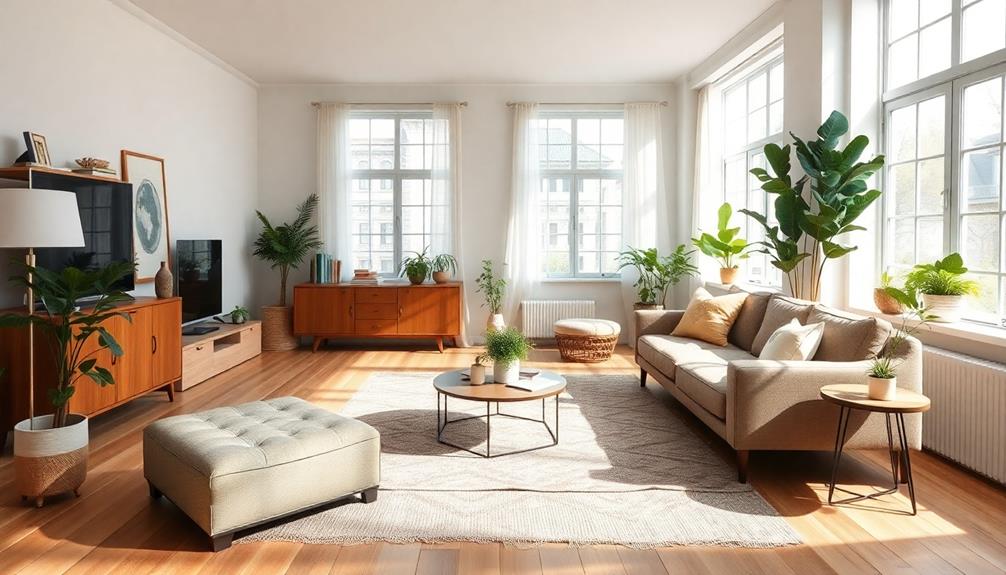
To achieve the perfect balance in interior decor, mix elements like color, texture, and lighting thoughtfully. Start with the 60-30-10 color rule for a harmonious palette, ensuring your dominant, secondary, and accent colors complement each other. Layer different textures to add depth—think smooth against rough surfaces. Incorporate ambient, task, and accent lighting to create a warm, inviting atmosphere. Finally, don't forget personal touches; unique decor pieces can enhance your space's character. With these tips, you're on your way to a balanced look that reflects your style—there's even more to explore for truly stunning decor!
Key Takeaways
- Utilize the 60-30-10 color rule to create a harmonious color palette with a dominant color, a secondary color, and an accent color.
- Incorporate a mix of textures and layers, such as combining smooth and rough materials, to add depth and warmth to your space.
- Choose between symmetrical and asymmetrical balance depending on the desired atmosphere, with symmetry for formal settings and asymmetry for a dynamic feel.
- Implement layered lighting techniques, including ambient, task, and accent lighting, to enhance visual balance and create a welcoming environment.
- Personalize your decor with unique pieces that tell your story while ensuring they complement the overall aesthetic for a cohesive look.
Understanding Balance in Design
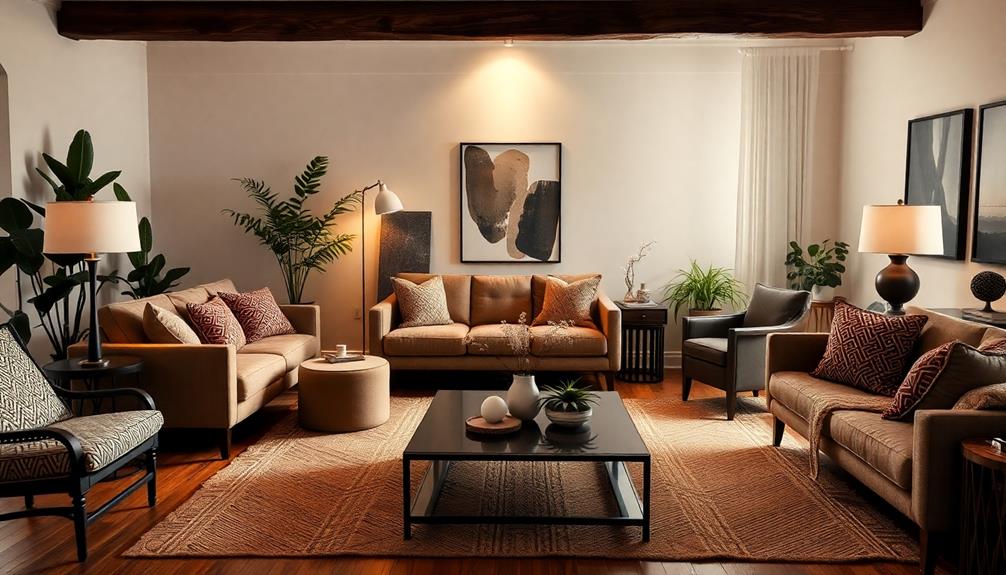
When it comes to interior design, understanding balance is key to creating a space that feels right. Balance refers to the distribution of visual weight, and you can achieve it through either symmetry in interior design or asymmetrical balance.
Symmetry offers a formal look, mirroring elements along a central axis, which enhances organization and flow. This method is perfect for spaces where you want to convey structure and order. Incorporating elements of Balinese design characteristics can further enhance this sense of balance by blending traditional craftsmanship with modern aesthetics.
On the other hand, asymmetrical balance introduces a more relaxed vibe. By juxtaposing different materials and shapes, you foster individuality and creative expression in your design. This approach allows for a more dynamic arrangement that can still feel cohesive.
Radial symmetry is another technique to contemplate; it centers design around a focal point, using circular arrangements to enhance intimacy and draw attention to key features.
Additionally, don't forget about your color palette. The 60-30-10 rule suggests having 60% dominant color, 30% secondary color, and 10% accents. Following these guidelines will help you in creating balance, ensuring your space feels harmonious and inviting.
Symmetrical Balance Techniques
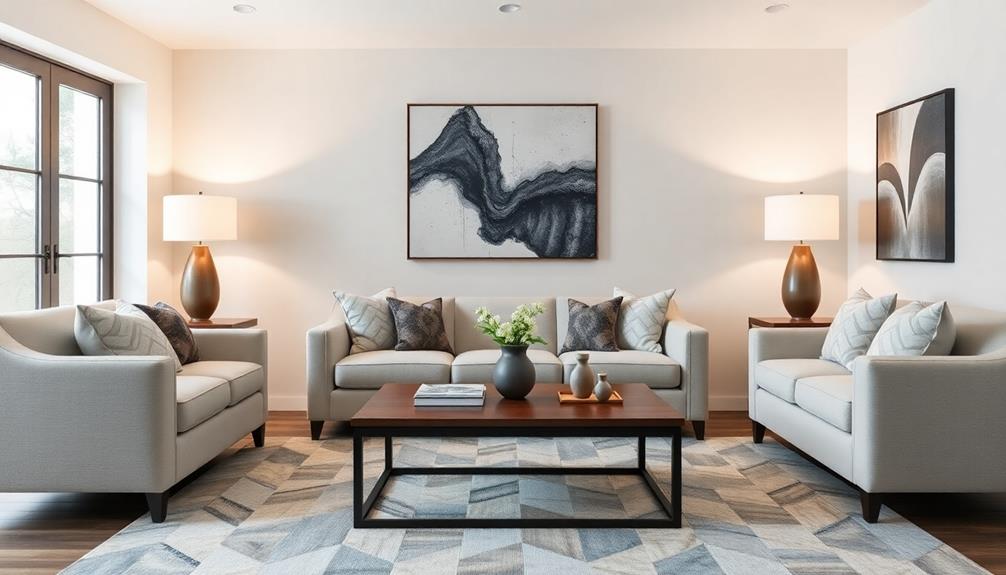
Symmetrical balance techniques create a sense of order and tranquility in your interior spaces. By mirroring elements on either side of a central focal point, you can achieve a harmonious look that conveys calmness. For instance, place identical lamps on either side of your sofa to create visual stability.
This approach is particularly effective in formal areas like living rooms, dining rooms, and entryways, where a dignified atmosphere is desired. To add warmth and character, consider incorporating Indonesian decorative pillows that feature vibrant colors and intricate patterns, which can also enhance the symmetry of your decor.
To enhance this symmetry, consider using a neutral palette that allows the balanced elements to stand out without overwhelming the space. When selecting accessories, make sure they carry equal visual weight, which can include varying their scale while keeping their arrangement consistent.
Area rugs can also play a vital role in anchoring your design. They visually connect furniture pieces, reinforcing the symmetrical balance and enhancing the overall organization of the room.
Exploring Asymmetrical Balance
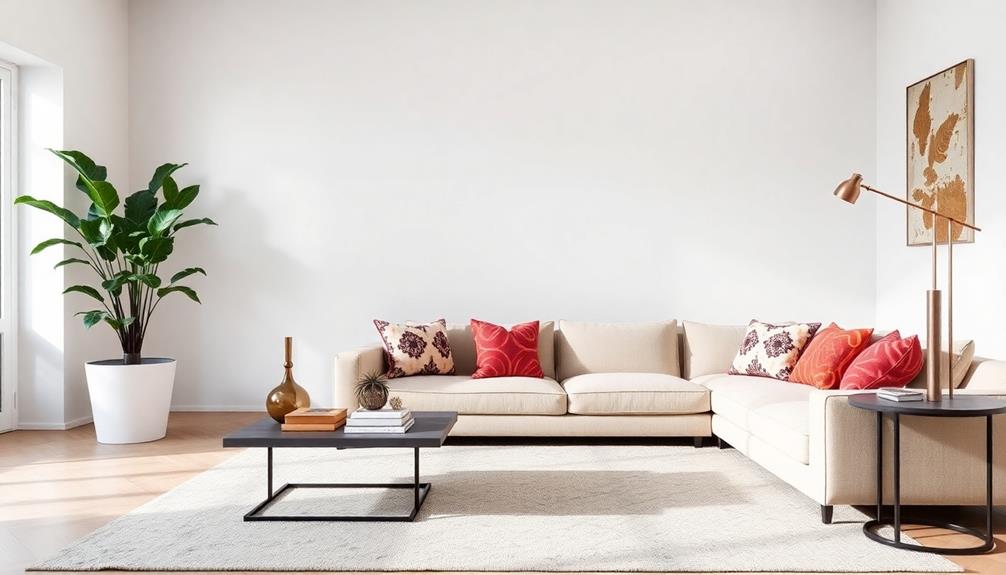
Asymmetrical balance brings a revitalizing, dynamic vibe to your interior spaces by distributing visual weight unevenly among diverse elements. This approach allows you to create a more personalized and eclectic design, employing different shapes, sizes, and materials to achieve harmony.
For instance, you might consider integrating natural materials like wood and stone, which can add warmth and depth to your decor while reflecting an emphasis on harmony with nature found in Traditional Indonesian Style Home Decor. By arranging items off-center, you harness creative expression while maintaining visual equilibrium.
Incorporating height and weight variations among furnishings can generate interest and movement within your space, preventing monotony and fostering individuality in decor. Think of how a tall vase might offset a low coffee table, creating a visual dialogue that draws the eye.
Achieving asymmetrical balance does require a keen eye for design, but the result is well worth it. Thoughtful placement of contrasting elements can create inviting and engaging interiors that resonate with your personal style.
This technique shines particularly in contemporary designs, where the juxtaposition of vintage and modern pieces enriches the overall aesthetic and emotional connection to the space.
The Power of Radial Symmetry
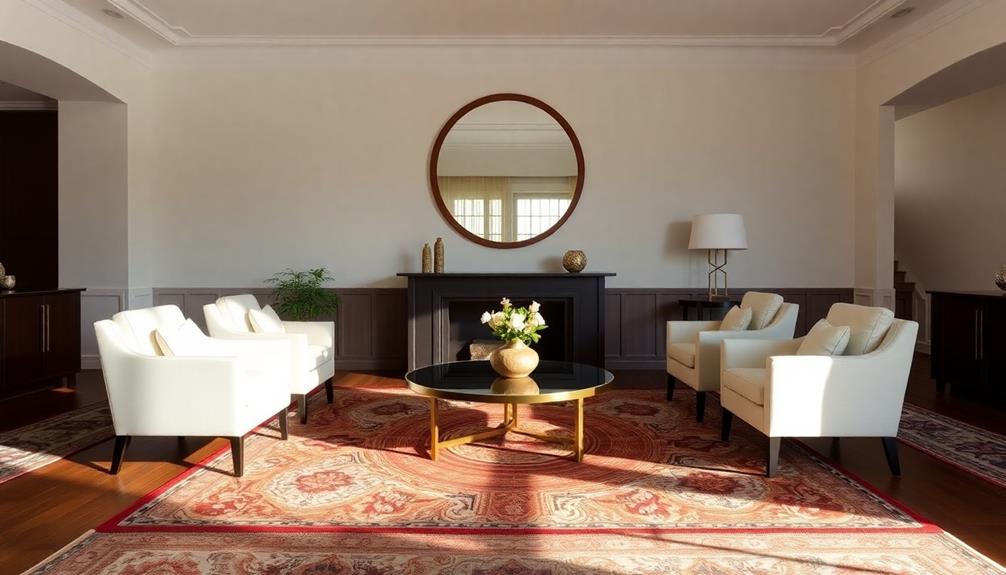
Emphasizing a central focal point, radial symmetry brings a unique harmony to your interior design that captivates and organizes. By arranging design elements around this focal point, you create balance that directs visual interest inward. This is particularly effective with circular layouts, like a well-placed dining table or an eye-catching lighting fixture, which fosters intimacy and conviviality in gathering spaces.
Incorporating high-quality materials, such as those utilized by Mahallati Interiors, further enhances the luxurious feel of your space.
Utilizing circular forms not only enhances visual balance but also improves spatial flow, as it naturally draws attention to the center of the arrangement. This cohesive aesthetic guarantees that every piece feels connected, making the space more inviting.
In areas with high ceilings, consider employing hanging fixtures or artwork that emphasizes downward movement toward the center. This not only enhances the radial symmetry but also adds a dynamic quality to the room, creating a lively atmosphere.
Incorporating radial symmetry into your interior design won't only promote balance but also encourage social interaction, making your home a welcoming environment.
Color Balance Strategies

When choosing your dominant color, think about how it sets the mood for the entire space.
Integrating accent colors can highlight key features, while repeating certain hues throughout helps create a cohesive look.
Dominant Color Selection
Selecting a dominant color is essential for achieving balance in your interior decor. The 60-30-10 color rule is a helpful guideline, where 60% of the room features the dominant color, 30% a secondary shade, and 10% for accents. This approach guarantees visual harmony and balance within your space.
Choosing a muted foundation color allows for versatility, letting you introduce vibrant accessories that can refresh your aesthetic. Repeating colors in furnishings, artwork, and decor creates unity, but don't shy away from contrasting colors to highlight focal points.
When considering visual weight, darker colors can ground larger pieces, while lighter shades open up spaces and create an airy feel. Confirm your color palette resonates with the mood you want to evoke; warm tones promote coziness, while cool tones offer calmness and relaxation.
| Color Type | Effect on Space | Example |
|---|---|---|
| Dominant Color | Sets the overall mood | Soft gray |
| Secondary Color | Complements the dominant color | Warm beige |
| Accent Color | Adds vibrancy and interest | Bright teal |
With these strategies, you'll find the perfect balance in your decor!
Accent Color Integration
Achieving harmony in your interior decor relies heavily on the thoughtful integration of accent colors. To create effective color balance, use the 60-30-10 rule: allocate 60% for the dominant color, 30% for a secondary color, and reserve 10% for accent colors. This approach guarantees visual weight and depth while enhancing the overall aesthetic.
Incorporating unique pieces such as an Indonesian decor mask can also serve as a striking accent that reflects cultural heritage and artistry.
When selecting your accent colors, consider their emotional impact. Warm tones like red and orange can energize a room, while cool shades such as blue and green promote relaxation. It's vital to confirm your accent colors contrast with both the dominant and secondary colors, adding visual interest without overwhelming the space.
For instance, a bold yellow paired with a muted gray creates a striking yet balanced look.
Repetition is key in creating symmetry and unity throughout your space. Use the same accent color in various areas, like throw pillows or art pieces, to pull the design together.
Don't forget to experiment with texture and materials; incorporating different textures enhances the overall depth of your color scheme, making your interior inviting and dynamic. Balancing these elements will elevate your decor and create an atmosphere that's both harmonious and engaging.
Repeating Color Themes
Repeating color themes throughout your space can transform the overall ambiance and create a sense of harmony. By applying the 60-30-10 color rule, you can establish visual weight, making 60% of your dominant color, 30% secondary colors, and 10% for accents. This approach fosters unity and cohesiveness in your interior design, much like how the eclectic style embraces diverse influences to create unique environments.
When choosing colors, consider repeating them in textiles, artwork, and accessories to maintain a consistent color palette. This not only enhances the flow between different areas but also creates a layered effect that adds depth and dimension.
Don't shy away from incorporating contrasting colors; strategically placed contrasts can highlight focal points without overwhelming the overall look. Using varying shades of the same color adds richness while preserving balance within your space.
Whether you're working with an open layout or individual rooms, keeping a consistent color palette guarantees that each area feels connected. By thoughtfully repeating color themes, you'll achieve a harmonious environment that reflects your style while maintaining visual interest.
Texture and Layering in Decor
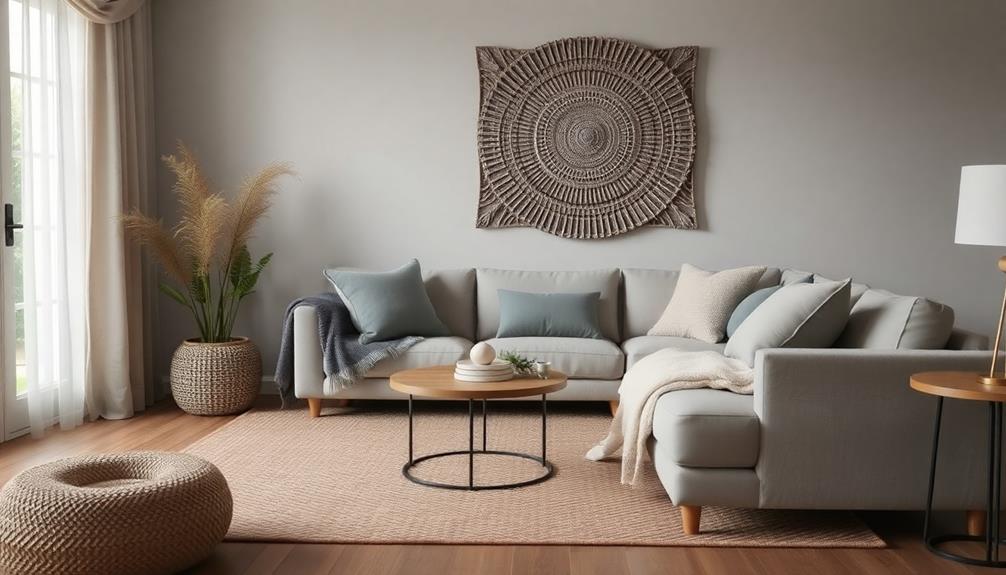
Incorporating a variety of textures and layering materials can transform your space into a dynamic and inviting environment. By mixing smooth fabrics, rough woods, and shiny metals, you create depth and visual interest, ensuring your decor doesn't feel flat or monotonous.
Layering is key; for instance, combining a soft wool throw with a leather sofa enhances comfort and establishes a warm atmosphere. Additionally, integrating natural elements such as jute or linen can enhance the overall texture, creating a more coastal color palette that resonates with a serene vibe.
Using varied textures also helps delineate different areas within your space. This is especially valuable in open layouts, as it promotes cohesion and organization. Balancing soft and hard textures—like plush cushions against a sleek coffee table—creates a striking contrast that captivates the eye.
Moreover, the thoughtful application of texture can evoke emotional responses. Softer textures often promote relaxation and comfort, making your space feel welcoming, while harder textures convey strength and stability, adding character.
Lighting for Visual Harmony
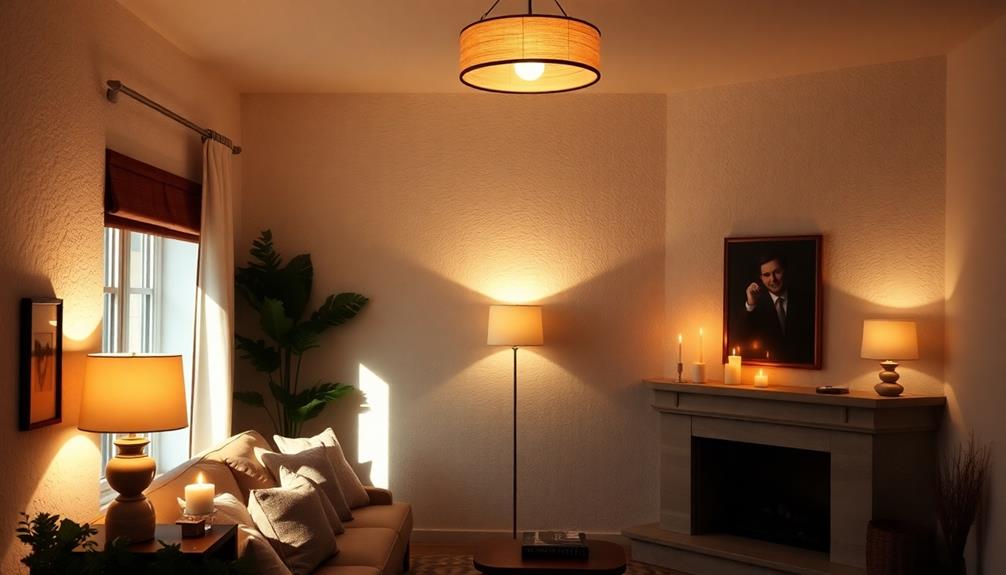
When it comes to achieving visual harmony in your space, layered lighting techniques are key.
You'll want to balance natural and artificial light to create an inviting atmosphere that enhances the overall design.
Incorporating LED lighting and plant growth can also help you achieve a vibrant environment while being energy efficient.
Layered Lighting Techniques
Layered lighting techniques offer a powerful way to transform your space into a harmonious retreat. By combining ambient, task, and accent lighting, you can create depth and visual harmony that enhances the overall balance in interior design.
Ambient lighting provides general illumination, filling the room with soft, even light that sets a welcoming atmosphere. Consider incorporating smart home theater design elements to optimize your lighting for various activities and moods.
Task lighting, on the other hand, zeroes in on specific areas, such as a reading nook or workspace, ensuring functionality without sacrificing aesthetic appeal. This focused lighting helps you perform activities comfortably and efficiently.
Accent lighting adds that extra flair by highlighting key design elements like artwork or architectural features. This draws the eye and adds interest, making your space feel more curated.
To achieve a cohesive look, maintain consistency in light temperature across your various light sources. This approach not only unifies the space but also enhances your well-being.
Natural vs. Artificial Light
Balance in lighting can greatly impact the overall feel of your space, as it harmonizes the interplay between natural and artificial light. Natural light enhances the ambiance, creating openness and a connection to the outdoors, while also affecting color perception. Artificial lighting, layered in ambient, task, and accent types, guarantees thorough illumination and visual harmony.
Here's a simple breakdown of how to achieve this balance:
| Type of Light | Purpose | Ideal Locations |
|---|---|---|
| Natural Light | Enhances ambiance | Living rooms, bedrooms |
| Ambient Lighting | General illumination | Hallways, dining areas |
| Task Lighting | Focused light for activities | Kitchens, home offices |
| Accent Lighting | Highlights features | Artwork, architectural details |
Utilizing warm light temperatures (2700K-3000K) fosters a cozy feel, while cooler temperatures (4000K-5000K) suit task-oriented spaces. Adjustable fixtures like dimmers allow you to modify intensity, adapting the mood for various activities. Finally, strategically placing mirrors amplifies natural light, creating a brighter, more balanced environment.
Personal Touches in Design
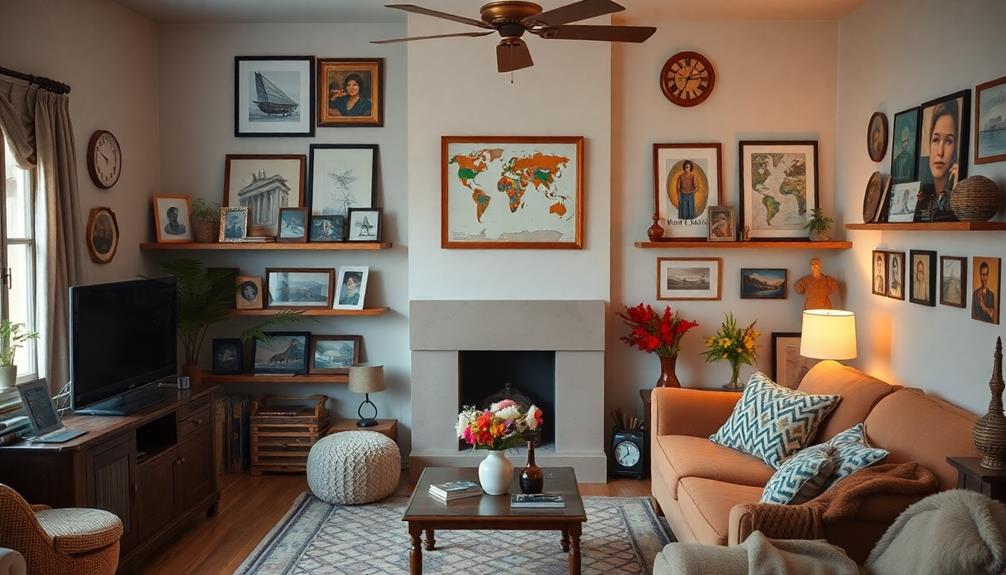
Incorporating personal touches in your interior design can transform a generic space into a reflection of your unique style and experiences. By thoughtfully placing items that resonate with you, such as Indonesian decor masks that represent rich cultural heritage, you create emotional connections that make your home inviting and relatable.
Here are some ideas to achieve that perfect balance:
- Unique Decor: Use decor pieces that tell your story, whether it's a handmade sculpture or a vintage find.
- Curated Collections: Showcase family heirlooms or travel souvenirs that add character and narrative to your space.
- Photographs: Display personal photographs in creative ways, such as gallery walls or shadow boxes, to evoke feelings of belonging.
- Art and Crafts: Incorporate handmade items or artwork that reflect your experiences, enhancing the aesthetic while maintaining a cohesive design.
Balancing these personal touches with your overall decor guarantees that your individuality shines through without overwhelming the space.
This approach contributes to a harmonious environment, allowing your home to truly represent who you are.
Frequently Asked Questions
How Do You Achieve Balance in Interior Design?
To achieve balance in interior design, use the 60-30-10 color rule, create symmetry with furniture arrangement, or embrace asymmetry for a dynamic look. Layer lighting to enhance depth, and regularly reassess your space for harmony.
How to Balance a Room When Decorating?
Balancing a room is like orchestrating a symphony; each element must harmonize. Start by evaluating colors and textures, then use area rugs and mix arrangements to create visual flow. Step back often to guarantee everything feels right.
What Are the Three Types of Balance in Interior Design?
In interior design, you can create balance through symmetrical, asymmetrical, and radial arrangements. Each type influences the space's mood, whether it's the orderliness of symmetry, the creativity of asymmetry, or the warmth of radial designs.
How Can You Create a Feeling of Balance in a Room?
You can create a feeling of balance in a room by using the 60-30-10 color rule, mixing textures, considering furniture scale, layering lighting, and allowing negative space for each element to shine.
Conclusion
Achieving the perfect balance in your interior decor is like crafting a beautiful symphony; every note matters. By blending symmetrical and asymmetrical elements, playing with colors, textures, and lighting, you create a harmonious space that feels just right. Don't forget to sprinkle in your personal touches, turning your home into a canvas that reflects who you are. Embrace these techniques, and watch as your decor transforms into a balanced oasis that invites you in and makes you feel at home. Consider incorporating natural elements such as plants or wood furniture to add warmth and depth to your space. By choosing furniture and decor that speaks to your personality and interests, you can truly transform your living space into a reflection of your unique style. Remember, the key to achieving the perfect balance is to be intentional in every design choice you make. Whether it’s a vintage rug handed down through generations or a bold piece of modern art, your unique interior decor tells a story and adds depth to your space. Let your personality shine through by curating a collection of items that speak to you and bring you joy. Embracing the perfect balance in your interior decor is not just about aesthetics, it’s about creating a space that nourishes your soul and invites you to truly feel at home.
Home Decor
The Feng Shui Furniture Rule That Will Instantly Improve Your Space
Get ready to transform your space with the Feng Shui furniture rule that promotes harmony and flow—discover how to elevate your environment today!
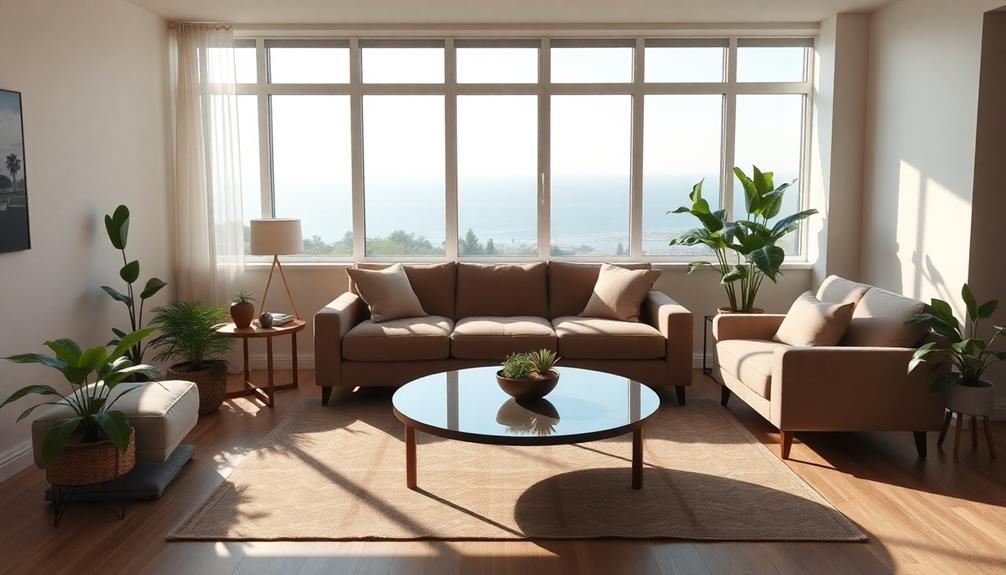
To instantly improve your space, position your furniture in the command position. This means placing key pieces like your bed or desk in a way that you can see the entrance while feeling supported by a solid wall behind you. Avoid pushing furniture against windows or corners to keep energy flowing. Make sure pathways are clear for easy movement. Adding natural elements, like plants, enhances this flow further. With a few tweaks, you can create a harmonious and inviting atmosphere. If you want to explore more ways to elevate your space, there's much more to discover!
Key Takeaways
- Position beds and desks in the command position to enhance energy flow and visibility of entrances for greater comfort and relaxation.
- Clear pathways and avoid clutter to facilitate movement, preventing energy stagnation and promoting tranquility within your space.
- Incorporate natural elements like plants to ground energy and refresh the atmosphere, enhancing vitality in your environment.
- Use soothing colors that resonate with you to influence mood and create a calming ambiance throughout your living space.
- Regularly reassess and update your furniture arrangement to align with personal growth, seasonal changes, and evolving preferences.
Understanding the Command Position
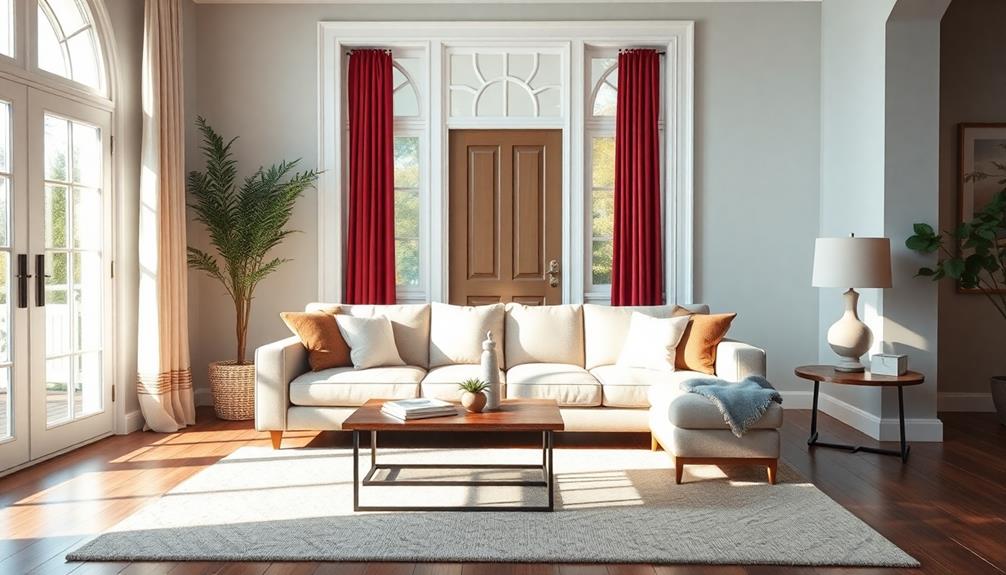
When you understand the command position, you can considerably enhance the flow of energy in your home. The command position refers to the strategic placement of furniture, particularly your bed and desk, allowing you to see the entrance while maintaining distance from direct sightlines. Incorporating elements like Indonesian decorative pillows can further enhance your space with their vibrant colors and intricate patterns, promoting a warm and inviting atmosphere. This setup fosters a sense of security and control, promoting relaxation.
In the bedroom, position your bed against a solid wall, ensuring you have visibility of the door while keeping pathways clear for ideal energy flow. This arrangement not only creates a peaceful sanctuary but also enhances your overall well-being.
In your living room, placing seating in a command position encourages conversation and interaction, enhancing the overall social atmosphere. Similarly, in your home office, position your desk to face the entrance, empowering you to feel aware of your surroundings while you work.
Avoid placing furniture against windows or crammed into corners, as this can disrupt energy flow and create feelings of vulnerability.
Balancing Energy Flow
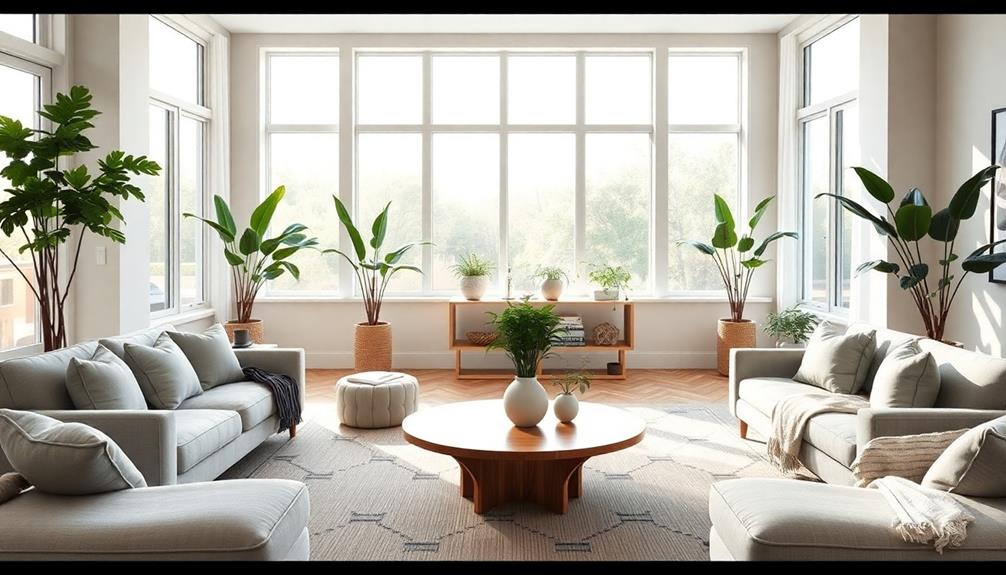
Mastering the command position sets the foundation for a harmonious living space, but balancing energy flow takes it a step further. To truly enhance your environment, focus on furniture arrangements that create clear pathways and avoid clutter. This allows energy to circulate freely and prevents stagnation.
Consider the following elements to improve your space:
| Element | Importance |
|---|---|
| Clear Pathways | Promote movement and prevent obstruction. |
| Natural Elements | Incorporate plants for grounding energy. |
| Soothing Colors | Use soft tones to enhance tranquility. |
| Visibility of Front Door | Foster comfort and reduce anxiety. |
Position larger furniture pieces to encourage interaction while ensuring visibility of entrances. This not only nurtures a sense of security but also supports social connections. Regularly reassess your furniture arrangement and embrace seasonal decor changes to maintain ideal energy flow. By doing so, you'll create a clutter-free environment that radiates balance and tranquility, transforming your space into a calming sanctuary. Prioritizing these aspects of Feng Shui will elevate your living experience and promote a serene atmosphere for you and your guests. Incorporating feng shui furniture ideas can also inspire creative layouts that maximize both functionality and harmony within your space. Consider using round tables to encourage equality in conversations or placing mirrors strategically to reflect natural light and amplify positive energy. These thoughtful adjustments will further align your home with Feng Shui principles, enhancing its overall warmth and inviting ambiance.
Optimal Furniture Placement
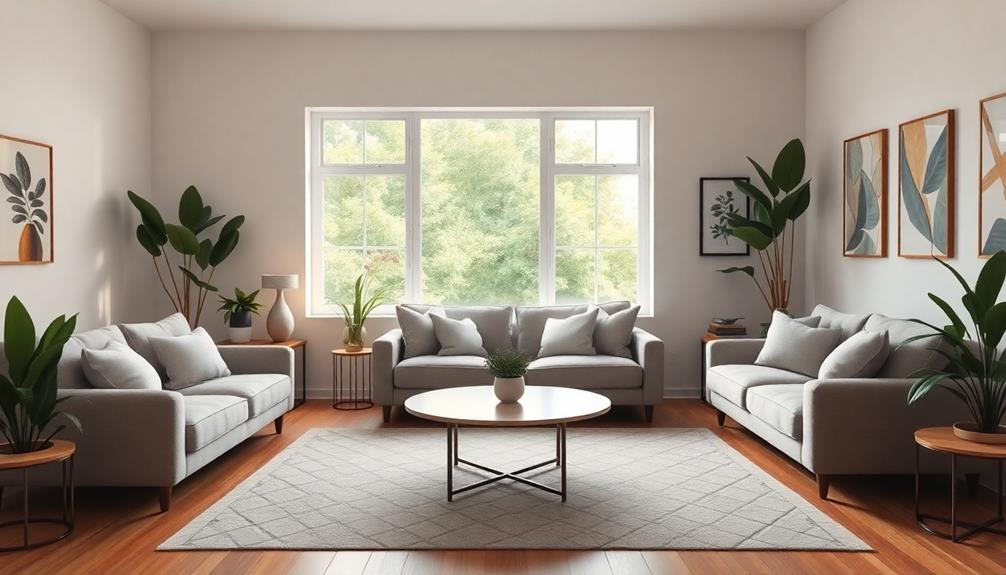
Optimal furniture placement is vital for creating a harmonious living space that promotes positive energy flow. To achieve ideal furniture placement, position larger pieces, like sofas, away from walls. This setup encourages an inviting atmosphere and facilitates conversation while ensuring you can see the front door for a sense of security.
Incorporating elements from Balinese design characteristics can further enhance the energy of your space by blending traditional craftsmanship with modern aesthetics. Avoid placing the back of the sofa against a window, as this blocks energy flow and may lead to feelings of instability.
Arrange seating to promote easy movement and interaction, keeping pathways clear to enhance overall energy. Incorporating natural elements, such as plants, can ground your space and elevate the energy. Place these near natural light sources for ideal growth, as they contribute to a vibrant environment.
Regular reassessments of your furniture arrangement are essential. By making seasonal adjustments, you can refresh your space, ensuring it continues to support your emotional well-being.
Always be open to tweaking your layout; sometimes, a simple shift can greatly enhance positive energy flow and create a more inviting atmosphere. Embrace these strategies to cultivate a space that nurtures both you and your guests.
Personalizing Your Space
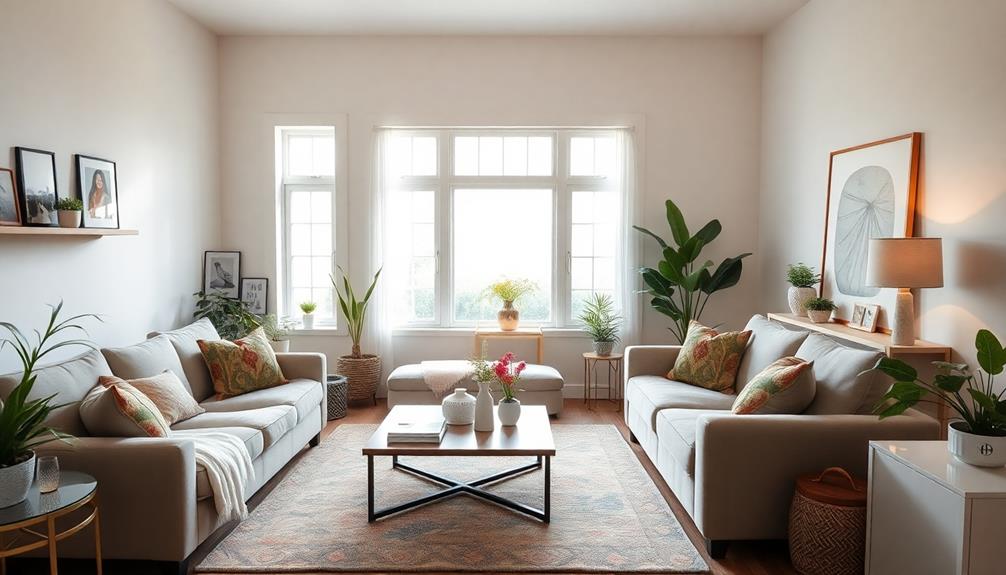
Personalizing your space transforms it into a reflection of who you are, making it feel more like home. Start by incorporating sentimental items like family photos or meaningful artwork, such as a unique Indonesian decor mask that represents rich cultural heritage. These pieces enhance your emotional connection to the space, fostering a sense of belonging.
Choose colors that resonate with you; they can greatly influence your mood and energy levels, promoting a calming atmosphere.
Don't forget to bring in natural elements such as plants and wood materials. These additions ground your space and provide a revitalizing connection to nature.
Regularly reassessing your decor allows you to reflect seasonal changes or personal growth, maintaining ideal energy flow and liveliness in your living area.
Thoughtful placement is key. Grouping objects in odd numbers can create visual appeal and elevate the overall harmony of the room.
Maintaining Harmony Over Time
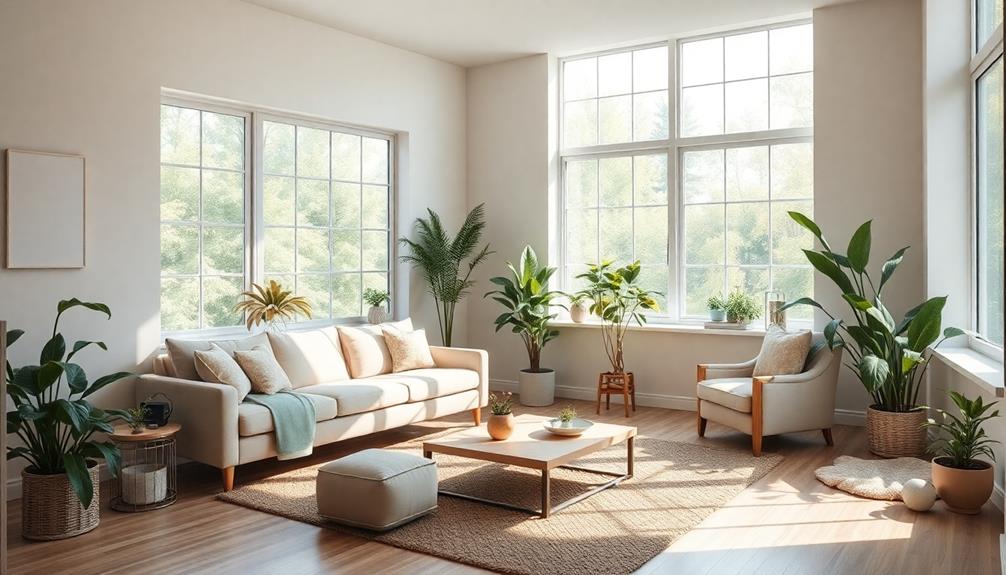
Maintaining harmony in your space is essential for fostering a positive and inviting atmosphere. To guarantee your environment promotes ideal energy flow, regularly reassess your furniture arrangement. Seasonal changes often call for adjustments, so keep your space feeling fresh and welcoming.
| Action | Purpose |
|---|---|
| Declutter | Prevent stagnant energy |
| Incorporate | Utilize natural elements |
| Personal items | Evoke positive emotions |
| Schedule updates | Keep energy dynamic |
| Refresh energy | Create a calming atmosphere |
By decluttering consistently, you'll prevent stagnant energy, allowing tranquility to flourish. Incorporating natural elements like plants can further refresh energy, creating a calming atmosphere that nurtures your well-being. Don't forget to include personal items that evoke positive emotions, enhancing the overall harmony of your space.
Lastly, schedule periodic updates to your decor and furniture placement. This keeps your living space aligned with your evolving preferences and lifestyle. Embrace these practices to maintain harmony over time, guaranteeing your home remains a sanctuary that supports your journey to well-being.
Frequently Asked Questions
How to Feng Shui Your Space?
To feng shui your space, arrange furniture for clear pathways, promote conversation with seating, incorporate natural elements, use calming colors, declutter regularly, and strategically place mirrors to enhance light and energy flow.
How to Place Furniture According to Feng Shui?
Placing furniture's like arranging a dance; you want partners to face each other. Position your seating to encourage conversation, clear pathways for movement, and always guarantee a view of the door for security and comfort.
How Can I Improve My Room Feng Shui?
To improve your room's feng shui, position your bed for visibility of the door, declutter pathways, use soothing colors, add plants, and regularly reassess your arrangement for ideal energy flow and tranquility.
How Do You Arrange Furniture for Positive Energy?
To arrange furniture for positive energy, create clear pathways, position seating to face the door, encourage conversation with your layout, and incorporate natural elements. Regularly refresh arrangements to maintain an uplifting atmosphere in your space.
Conclusion
By following these feng shui principles, you can transform your space into a sanctuary that feels both inviting and balanced. Remember, it's all about creating harmony and flow. Have you considered how your furniture placement affects your daily energy? With a little mindfulness and personalization, you'll not only enhance your surroundings but also elevate your mood. Keep reassessing and adjusting as needed to maintain that perfect balance and guarantee your space continues to inspire you.
Home Decor
Why These 5 Feng Shui Principles Will Make Your Home Feel Complete
Transform your living space with these five Feng Shui principles that promise harmony and balance—discover how they can make your home feel truly complete.
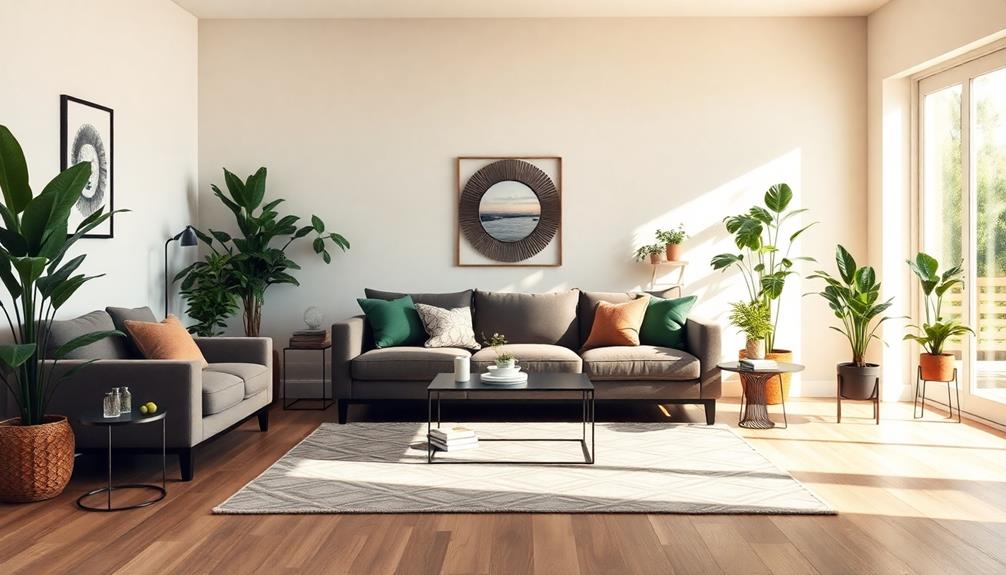
Incorporating these five Feng Shui principles can transform your home into a place of tranquility and balance. Start by decluttering to enhance energy flow and reduce stress, making your space feel inviting. Next, arrange your furniture strategically to promote good Chi and create functional zones. Thoughtful mirror placements can amplify light and positivity, while balancing the five elements in your decor fosters harmony and boosts relaxation. With these principles, you'll find your home feels complete and rejuvenating. Stick around to uncover even more ways to enhance your living space!
Key Takeaways
- Embracing Feng Shui principles enhances the flow of Chi, creating a lively and harmonious atmosphere in your home.
- Decluttering promotes positive energy circulation, reducing stress and chaos, leading to a more peaceful living space.
- Strategic furniture arrangement fosters an inviting environment, ensuring comfort and functionality in various areas of your home.
- Thoughtful use of mirrors boosts light and energy flow, reflecting positive elements and enhancing the overall ambiance.
- Balancing the five elements in design promotes relaxation and productivity, creating a sense of completeness and well-being in your home.
Understanding Feng Shui Principles
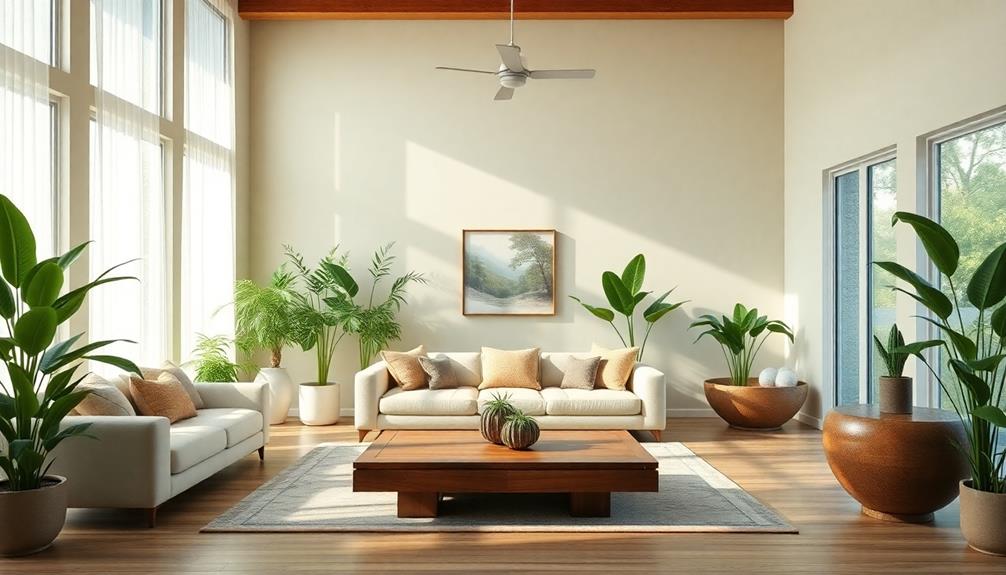
Feng Shui, an ancient Chinese practice, emphasizes the importance of energy flow, or Chi, in your living space. By understanding Feng Shui principles, you can create a balanced and harmonious environment that nurtures your well-being.
Central to this practice is the concept of Chi energy, which flows through your home, influencing your mood and liveliness. To enhance this flow of energy, consider incorporating elements of traditional Indonesian style home decor, which utilizes natural materials and emphasizes harmony with nature.
The Bagua Map serves as an essential tool, dividing your space into nine zones linked to different life aspects like wealth and health. Each zone can be activated by incorporating the five elements: Wood, Fire, Earth, Metal, and Water, ensuring a dynamic and organized space.
Feng Shui design also encourages the use of specific colors and materials to promote positive energy flow. For example, pink may attract love, while green can boost finances.
Additionally, integrating symbols like wind chimes or water features can further enhance the energy in your home.
Importance of Decluttering
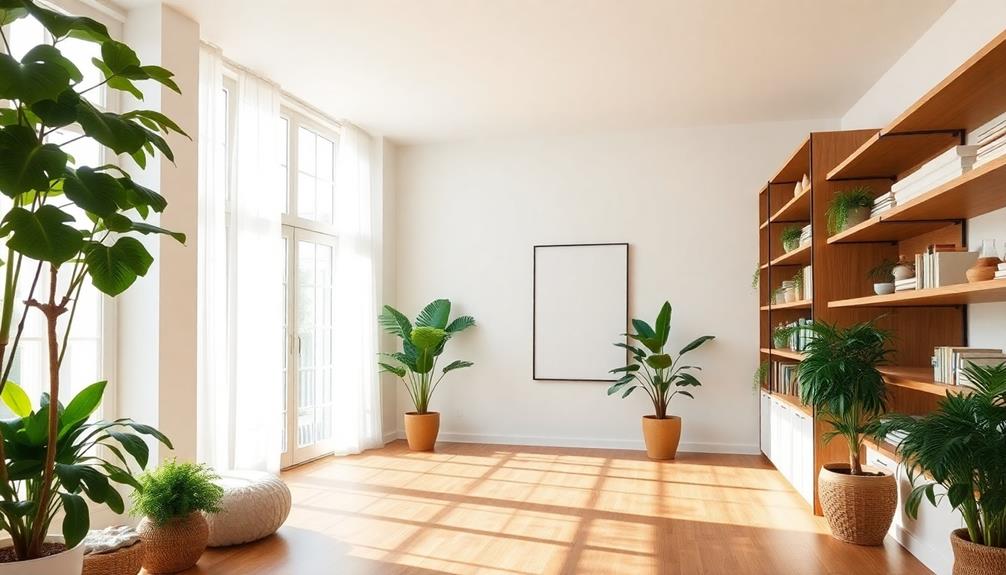
Decluttering is essential for maintaining a harmonious home, as it directly impacts the flow of chi, or energy, throughout your space. In Feng Shui, a clutter-free environment allows positive energy to circulate freely, enhancing your overall well-being. When you regularly declutter, you reduce chaos and stress, fostering mental clarity and emotional stability.
Here's how decluttering can transform your living space:
| Benefits of Decluttering | Effects on Well-being | Tips for Decluttering |
|---|---|---|
| Promotes positive energy | Reduces anxiety | Start small, focus on one area |
| Enhances relaxation | Improves sleep quality | Donate unused items regularly |
| Encourages creativity | Boosts mental clarity | Organize spaces effectively |
| Opens space for opportunities | Fosters emotional balance | Visualize your ideal space |
Strategic Furniture Arrangement
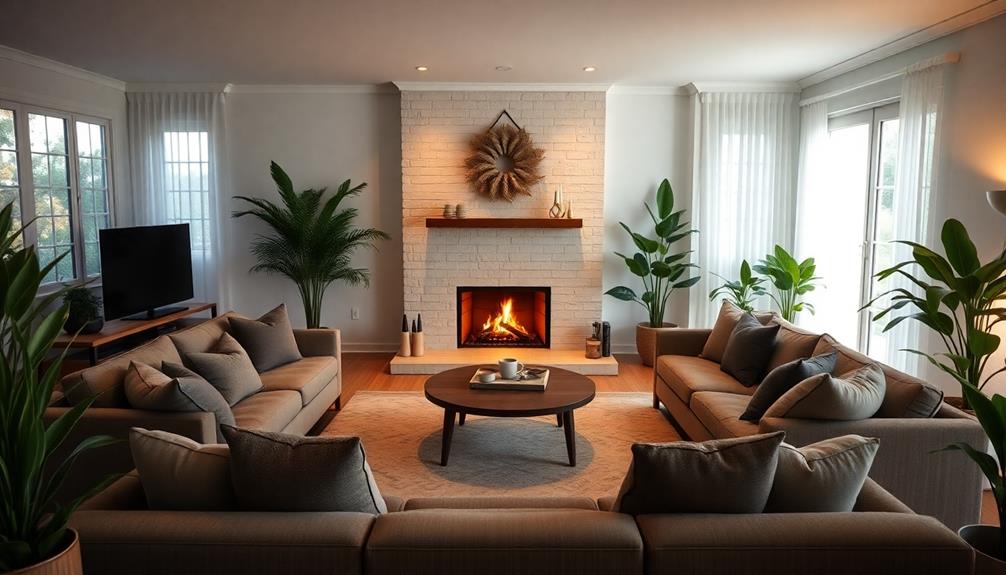
Arranging your furniture strategically can greatly enhance the flow of chi in your home, creating a more inviting and harmonious atmosphere. By positioning key pieces, like sofas and desks, to allow for clear visibility of entryways, you reduce feelings of vulnerability and boost comfort.
One essential element is placing your bed in a command position; ideally, it should face the door without being directly aligned with it. This arrangement promotes security and relaxation, crucial for restful sleep. Incorporating natural materials and earth tones, much like in Balinese interior design concepts, can further enhance the calming effect of your space.
Avoid sharp corners pointed toward seating areas, as they can foster discomfort and anxiety, disrupting your harmonious living space. Instead, utilize furniture to create distinct functional zones within a room. This encourages energy flow and supports various activities, enhancing the overall utility and vibe of your space.
Regularly reassessing your furniture placement can help maintain a balanced environment, allowing you to make adjustments that reflect your changing needs and preferences.
Thoughtful Use of Mirrors
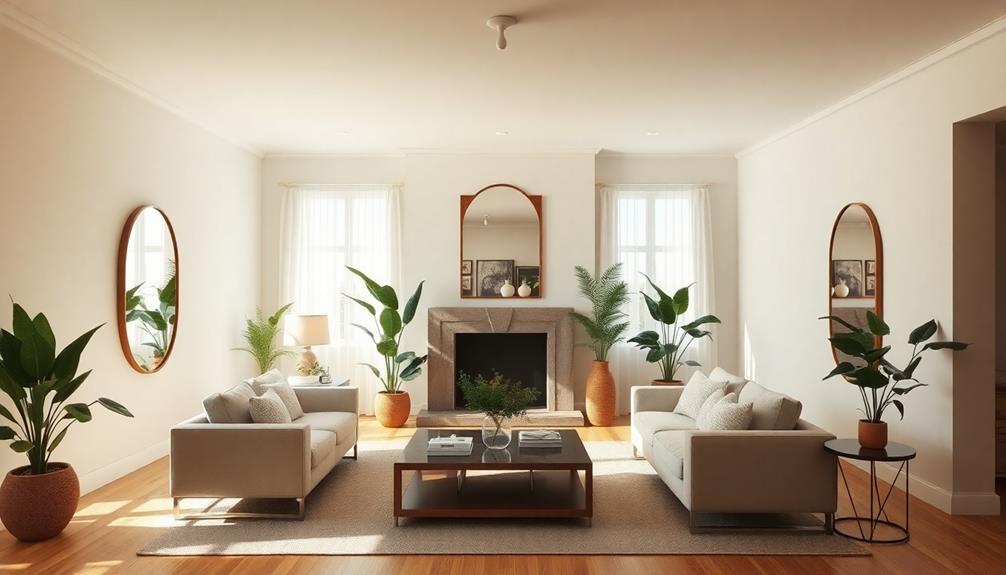
Mirrors can be powerful tools in your home when used thoughtfully, enhancing both light and energy flow. In Feng Shui, the strategic placement of mirrors can greatly impact your living space.
For instance, incorporating elements like traditional artistry through vibrant Indonesian decor masks can complement the energy reflected by mirrors. Position them to reflect positive elements like plants or artwork, which amplifies good energy and promotes a sense of spaciousness.
Avoid placing mirrors directly facing beds or front doors, as this can lead to restlessness and energetic chaos. To maintain a peaceful environment, consider covering mirrors at night. This simple action helps mitigate any negative effects on your sleep, allowing for a more restful night.
Large mirrors can create the illusion of more space, but be cautious not to reflect clutter or negative imagery, as this can disrupt harmony in your home. Regularly evaluate your mirror placements to verify they support the desired energy flow and atmosphere in each room.
An organized approach to mirrors not only reflects your style but also contributes to a serene atmosphere, fostering positive energy throughout your home. Thoughtful use of mirrors can transform your space, making it feel complete and inviting.
Balancing Elements in Design
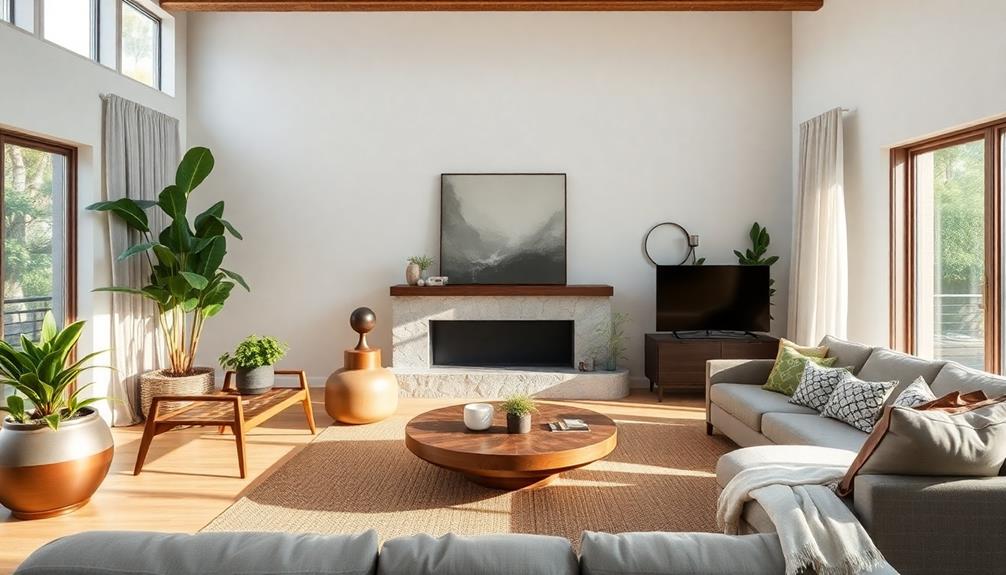
How can you create a harmonious environment in your home? Balancing the five elements—wood, fire, earth, metal, and water—is crucial for enhancing energy flow and promoting relaxation. Each element influences mood and energy, so incorporating them thoughtfully in your home design can greatly improve the quality of your space.
For example, vibrant colors and intricate patterns found in Indonesian decorative pillows can enhance the wood element, evoking feelings of growth and liveliness, while metal accents can provide clarity and structure. Understanding how these elements interact helps you avoid deficiencies; adding water features or blue decor can counteract excessive fire energy, ensuring balance and harmony throughout your home.
Utilizing Feng Shui principles, a chart can guide you in identifying which elements are lacking in your space. This way, you can make informed design choices that foster emotional and physical well-being.
Aiming for a balanced element composition not only enhances your home's aesthetic appeal but also creates a peaceful and calming atmosphere, boosting relaxation and productivity. With these adjustments, you'll cultivate a harmonious environment that resonates with positive energy and tranquility.
Frequently Asked Questions
What Are the 5 Principles of Feng Shui?
The five principles of Feng Shui are Chi Flow, Yin and Yang, the Five Elements, Clutter Clearing, and the Bagua Map. Each principle helps you create a balanced, harmonious, and energetically supportive home environment.
What Are the 5 Elements of Feng Shui?
The five elements of Feng Shui are Wood, Fire, Earth, Metal, and Water. Each element represents unique qualities and energies that influence your space and well-being, guiding you to create a harmonious environment.
How to Use Feng Shui in Your Home?
Transforming your home into a sanctuary could feel like magic! You can use feng shui by decluttering, arranging furniture wisely, adding natural elements, choosing soft colors, and enhancing lighting to create a harmonious, inviting space. Incorporating a feng shui color palette can further elevate the energy in your home, promoting balance and positivity. Opt for soothing hues like gentle greens, calming blues, or warm earth tones to foster a sense of peace and well-being. These thoughtful design choices not only enhance the visual appeal of your space but also nurture your emotional and spiritual connection to your environment.
How Important Is Feng Shui in a House?
Feng Shui's essential for your house because it optimizes energy flow, creating a balanced environment. When you embrace its principles, you enhance your well-being, promote relaxation, and foster a sense of harmony in your space.
Conclusion
By applying these five feng shui principles, you can create a harmonious space that feels complete and inviting. Decluttering not only clears physical space but also promotes mental clarity. When you arrange furniture thoughtfully and use mirrors strategically, you enhance energy flow. Balancing the five elements in your design fosters a sense of equilibrium. While some may debate the scientific basis of feng shui, many find that its practices enhance well-being, proving that intention can shape our environments profoundly.
Home Decor
The Ultimate Guide to Using Feng Shui for Maximum Peace in Your Space
Journey into the world of Feng Shui and discover secrets to transform your space into a serene sanctuary that enhances your well-being.
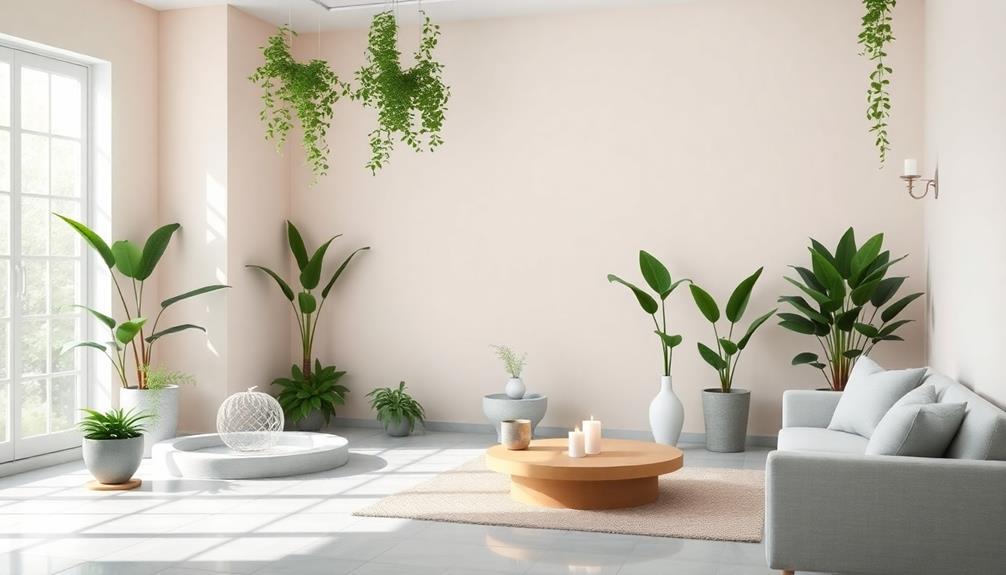
To achieve maximum peace in your space through Feng Shui, focus on creating a harmonious energy flow. Start by decluttering to allow Chi to circulate freely. Incorporate the five elements—Wood, Fire, Earth, Metal, Water—to balance your environment. Use the Bagua map to enhance specific life areas, and strategically place soft lighting and plants for tranquility. Choose calming colors and arrange your furniture to facilitate connection. Remember, your space should reflect your personality and intentions to amplify positive energy. This guide can reveal more techniques to guarantee your environment fosters a peaceful atmosphere conducive to well-being. Don’t forget to pay attention to your entryway, as it serves as the gateway for energy entering your home; keeping it clean and inviting is essential. Mirrors can be another powerful tool to amplify light and energy, but be mindful of their placement to avoid reflecting negative vibes. By taking these small but impactful steps to feng shui your living space, you can create a sanctuary that nurtures balance, calmness, and positivity in your daily life.
Key Takeaways
- Create a harmonious flow of energy (Chi) by decluttering and organizing your space regularly to promote positivity and tranquility.
- Utilize the Bagua map to identify and enhance specific life areas, aligning your space with your personal goals.
- Incorporate natural elements like plants and water features to elevate energy flow and foster a calming atmosphere.
- Use soft, neutral color palettes and strategic lighting to create a relaxing environment that promotes peace and comfort.
- Position furniture thoughtfully in each room, ensuring clear pathways and a commanding placement for restful energy and productivity.
Understanding Feng Shui Principles
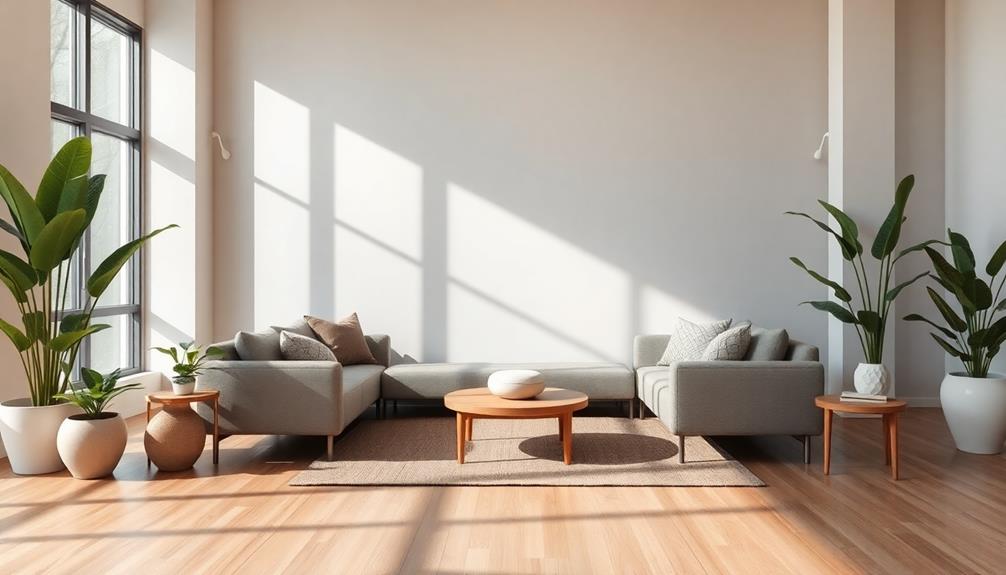
Feng Shui is all about creating a harmonious flow of energy, or Chi, within your space. By understanding the core Feng Shui principles, you can enhance your well-being and invite positive energy into your life.
Central to this practice is the balance of Yin and Yang, which represents passive and active energies respectively. This balance is essential for ensuring that your environment feels harmonious and supportive. You can enhance your space further using elements of Indonesian decorative pillows that add vibrant colors and intricate patterns, promoting comfort and cultural richness.
You can incorporate the five elements—Wood, Fire, Earth, Metal, and Water—into your space to further influence the flow of energy. Each element corresponds to specific colors and shapes, allowing you to tailor your environment to promote desired outcomes, whether it's prosperity, health, or relationships.
Utilizing the Bagua map can help you identify which areas of your life you want to enhance. By dividing your space into nine life areas, you can strategically arrange furniture and decor to amplify energy in those specific zones.
Key Feng Shui Tools and Symbols
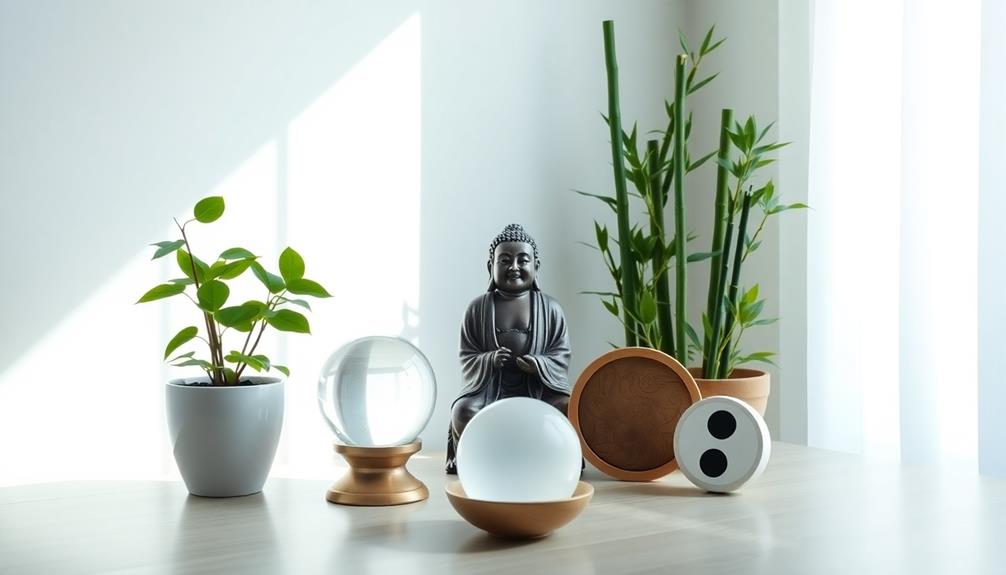
To create harmony in your space, you'll want to explore the Bagua Map and the significance of Celestial Animals.
Incorporating elements such as traditional artistry can enhance the energy flow, while vibrant decorations may uplift your spirits and promote positivity.
The Bagua Map helps you identify areas of your life that need attention and improvement, while the Celestial Animals symbolize guidance and support in various aspects.
Understanding these tools can enhance the energy flow in your environment, leading to greater peace and balance.
Celestial Animals Overview
In the world of Feng Shui, celestial animals serve as powerful symbols, each one embodying unique energies that can influence various aspects of your life. The Green Dragon, representing your career, is associated with the east and promotes growth and liveliness. To harness its energy, consider incorporating its image in your workspace.
Additionally, you can enhance the workspace's ambiance by using natural materials and earth tones, reflecting the calming effects of Balinese design principles. The White Tiger, linked to relationships, symbolizes strength and protection and is connected to the west. Displaying this symbol can help create balanced and harmonious interactions with others.
For health, the Black Tortoise is your ally, representing stability and support. Found in the north, its energy can enhance your well-being when included in your living space.
Finally, the Red Phoenix, representing wealth and fame, is connected to the south and encourages recognition and prosperity. By integrating these celestial animals into your environment, you can focus on enhancing specific life areas.
Understanding these symbols allows you to tap into their energies effectively. By consciously placing representations of these celestial animals around you, you can cultivate a more balanced and harmonious life.
Embrace their unique qualities to transform your space and invite positive changes.
Bagua Map Explained
The Bagua Map is an essential tool for anyone looking to enhance the energy in their space. This powerful Feng Shui tool divides your environment into nine areas, each linked to different aspects of life, such as Wealth, Love, and Career. By using the Bagua map, you can target specific areas to boost positive energy in your home or office.
Incorporating elements of traditional Indonesian style home decor can further enhance the harmony and tranquility of your space, using natural materials and intricate designs that resonate with nature.
To apply the Bagua map, align it with the main entrance of your space. Each section will correspond to the areas of life it represents, making it easier for you to adjust your decor accordingly. For instance, the Wealth area is often associated with the color purple and the Wood element. By incorporating these colors, shapes, and symbols, you can amplify positive energy and improve your financial situation.
You don't need a large space to benefit from the Bagua map; even small adjustments can greatly enhance energy flow without extensive renovations.
Whether you're a renter or simply want to refresh your space, using these Feng Shui techniques can help you create a harmonious environment that nurtures all aspects of your life.
Essential Feng Shui Dos and Don'ts
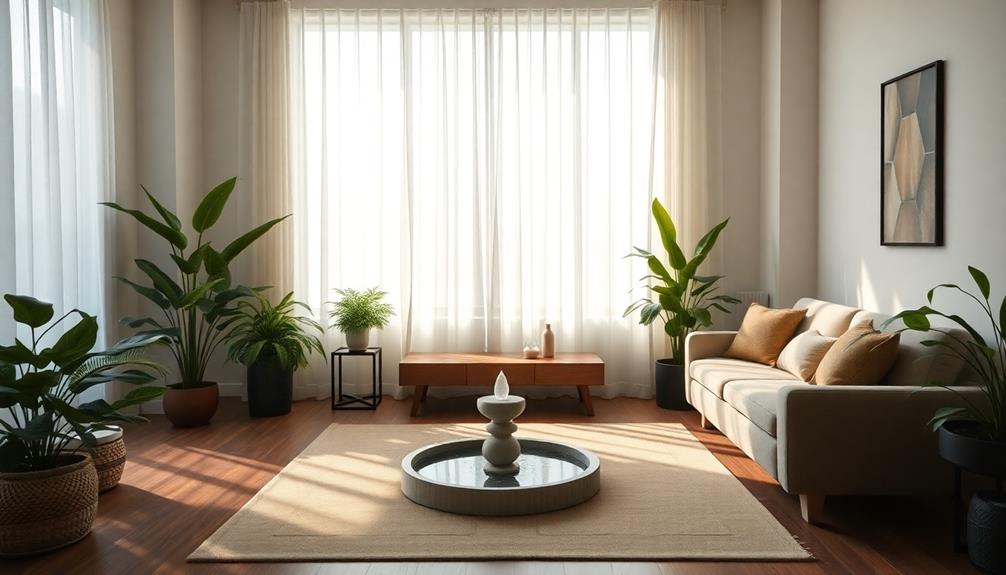
Creating a harmonious living space requires attention to certain Feng Shui principles that can greatly impact your well-being. To start, you should declutter regularly. Clutter blocks Chi, the life force energy, and creates chaos in your environment, so keeping your space tidy is essential for maintaining positive energy flow.
Incorporating elements of cultural decor, such as Indonesian decor masks, can also enhance the aesthetic appeal and storytelling aspect of your space, enriching the overall ambiance.
Incorporating soft, calming colors like neutrals and pastels can enhance relaxation. Avoid overwhelming bright colors, as they can induce stress.
Another effective Feng Shui tip is to bring in plants. They improve air quality and enhance vigor, contributing to a harmonious atmosphere.
On the flip side, don't place furniture in a way that blocks pathways or doors. This restriction hinders energy movement and can lead to stagnant energy, which you definitely want to avoid.
Additionally, don't ignore broken items in your space. They symbolize stagnation and can hinder your progress. By repairing or removing these items, you open the door for new opportunities.
Room-Specific Feng Shui Guidelines
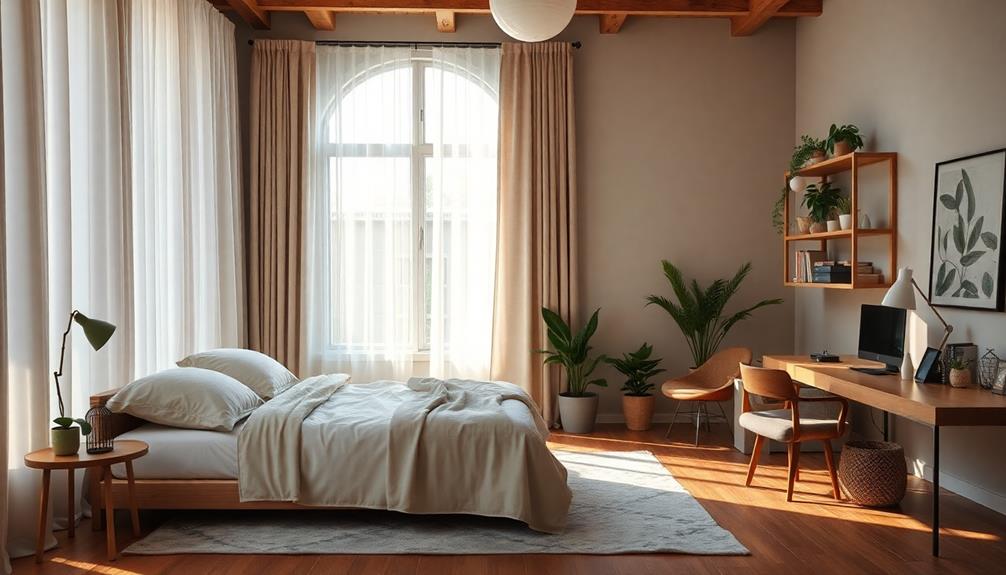
Every room in your home has its own unique energy, and applying Feng Shui principles can amplify that vibe.
Start by arranging your living room furniture to create a welcoming flow, ensuring seating allows for a clear view of the entrance, promoting safety and comfort.
In the kitchen, keep the stove and sink clean, as they symbolize nourishment; clutter can block the flow of positive Chi.
For the bathroom, maintain cleanliness and privacy by keeping the toilet lid closed and the door shut. Adding plants purifies the air and balances water energy.
In your bedroom, position the bed in a commanding position facing the door, allowing for space on both sides, and use calming colors to foster restful sleep.
Finally, in your office, place your desk in a commanding position to boost productivity and creativity, while keeping the workspace clutter-free for the free flow of ideas and energy.
- Arrange furniture for welcoming flow
- Keep kitchen spaces clean and organized
- Maintain bathroom privacy and cleanliness
- Position bed for restful sleep
- Place desk to encourage productivity
Enhancing Energy Flow
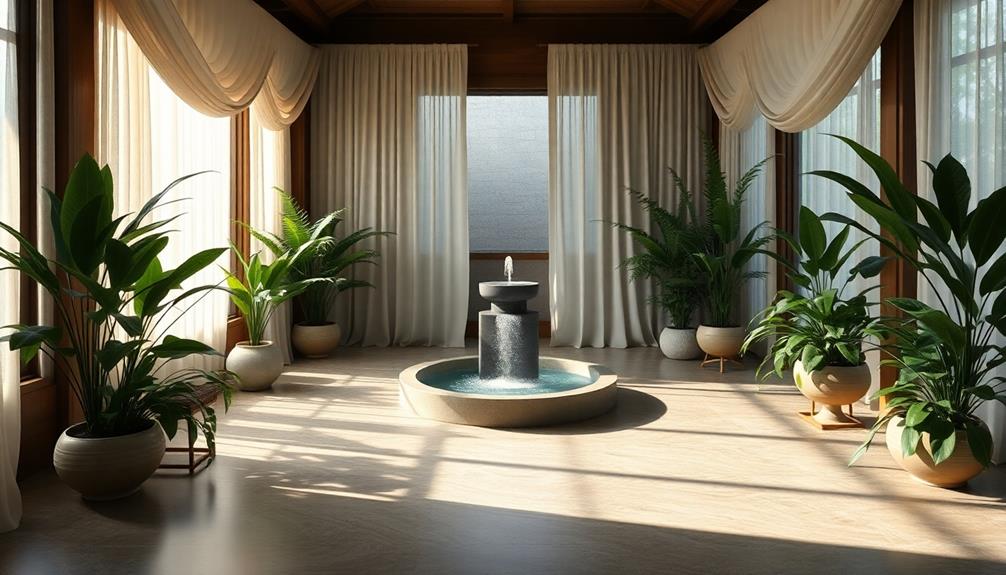
To enhance energy flow in your home, focus on keeping pathways clear and decluttering regularly. This practice guarantees a smooth flow of Chi energy, promoting peace and tranquility.
Start by evaluating each room; remove any items that don't serve a purpose or bring you joy. Additionally, consider incorporating elements from luxury tropical designs that blend natural beauty with modern aesthetics, which can elevate the overall harmony of your space.
Incorporating natural elements like plants and water features can markedly enhance energy flow. These elements are tied to liveliness and abundance in Feng Shui, so consider adding a small fountain or potted plants to your space.
Soft, warm lighting also plays an essential role. Utilize strategic lighting and mirrors to reflect and amplify positive energy, making your environment feel more open and inviting.
Don't forget to regularly refresh your surroundings. Rearranging furniture and decor stimulates energy movement, preventing stagnation and enhancing harmony.
An organized space not only supports energy flow but fosters a calming atmosphere conducive to relaxation and well-being.
Creating a Calming Home Environment
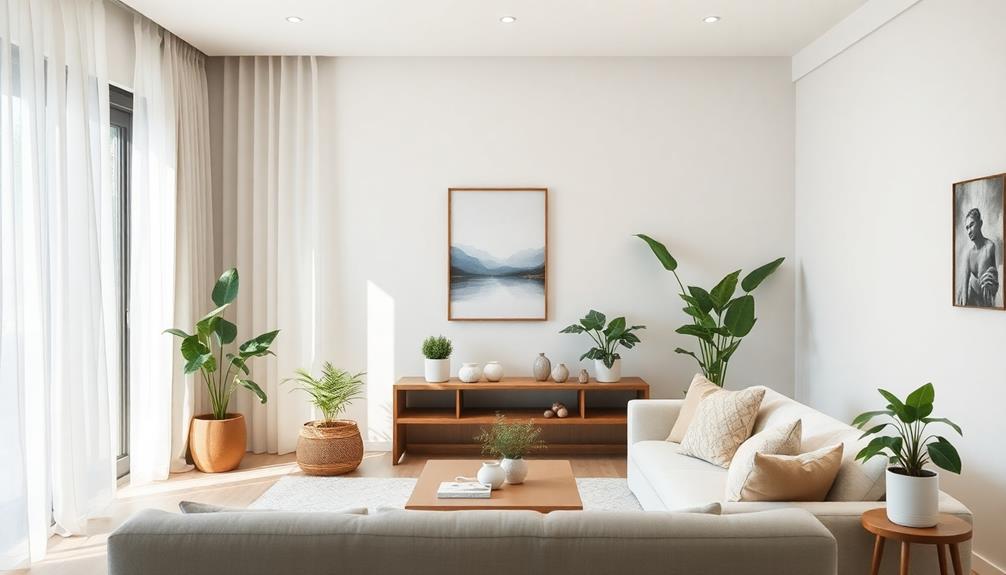
To create a calming home environment, start by choosing a soft color palette that includes soothing shades like light blues and greens.
This choice not only promotes relaxation but also enhances the overall atmosphere of your space.
Consider incorporating elements of tropical villa plans that emphasize open spaces and natural light to further cultivate serenity.
Pair these colors with strategic lighting, using warm lights and dimmers to foster a comforting ambiance that invites peace and tranquility.
Soft Color Palette
Choosing a soft color palette can transform your living space into a sanctuary of peace and relaxation. By incorporating neutral hues like soft whites, gentle beiges, and light pastels, you'll create a peaceful and calming atmosphere that aligns with Feng Shui principles.
Colors such as light blue and pale green are perfect for bedrooms and meditation areas, promoting restful energy essential for rejuvenation. Additionally, embracing traditional Indonesian housing aesthetics can inspire your color choices, as they often utilize local materials and soothing tones to create harmony with the environment.
To enhance the calming energy in your home, consider these ideas:
- Use soft browns and muted yellows to evoke a grounding atmosphere.
- Opt for shades that create serenity, avoiding overwhelming bright colors.
- Choose a monochromatic scheme or analogous colors for visual cohesion.
- Incorporate Earth element colors for stability and nourishment.
- Keep decor minimalistic to maintain a sense of order.
Strategic Lighting Placement
Strategic lighting placement plays an important role in creating a calming home environment. By using soft, warm lighting, you can greatly enhance comfort and relaxation in your space. Consider installing dimmer switches to adjust lighting levels based on the time of day and your mood. This flexibility helps foster a serene ambiance crucial for maintaining positive Chi.
Additionally, incorporating elements of Indonesian wedding decor can inspire unique lighting designs that reflect cultural richness and warmth.
Incorporate natural light by maximizing windows and reflective surfaces, which not only elevate your energy levels but also promote a sense of openness and connection to nature. This connection is essential for your overall well-being.
Position your lights to illuminate key areas like reading nooks or artwork, establishing focal points that draw the eye and create balance within the room.
Layered lighting is another effective strategy. By combining ambient, task, and accent lighting, you guarantee a harmonious balance that adapts to various activities and needs. This approach contributes to a more peaceful home environment, allowing you to feel more at ease.
Benefits of a Peaceful Space
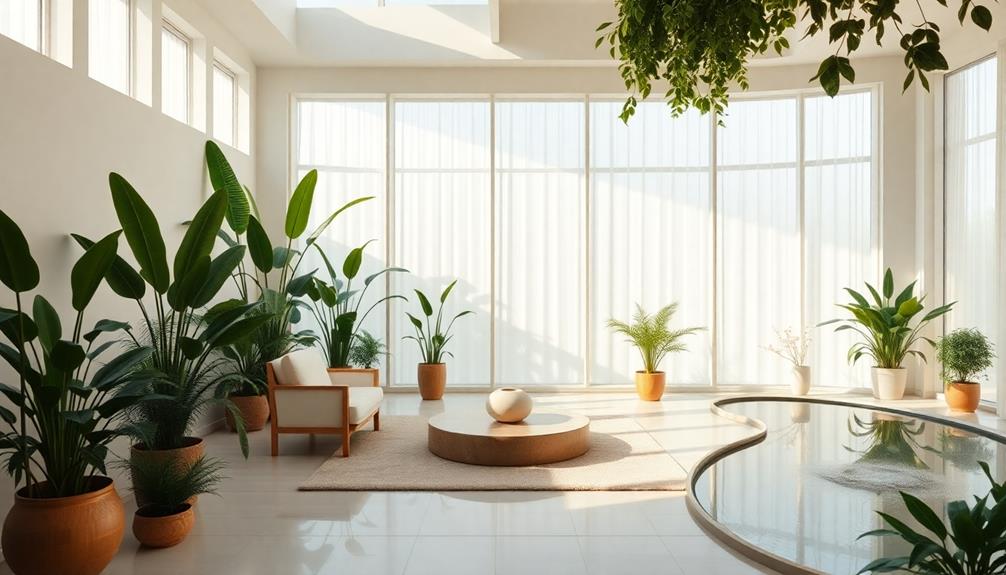
Creating a peaceful space offers numerous benefits that can markedly enhance your daily life. When you cultivate an environment focused on tranquility, you'll experience improved mental clarity and the ability to concentrate on tasks without distractions.
Incorporating elements such as an Indonesian decor mask can also add a unique cultural touch to your space, enriching the ambiance and promoting appreciation for traditional craftsmanship. Research shows that calming surroundings can elevate your mood and emotional stability, leading to greater overall well-being.
Here are some key benefits of a peaceful space:
- Enhanced focus: Better concentration on tasks and projects.
- Improved mood: A serene environment can boost your emotional health.
- Restful sleep: A well-organized space encourages relaxation and recovery.
- Life satisfaction: Thoughtful design fosters healthy relationships and a sense of belonging.
- Reduced stress: Decluttering creates a tidy environment, allowing you to recharge effectively.
Personalizing Your Feng Shui Approach
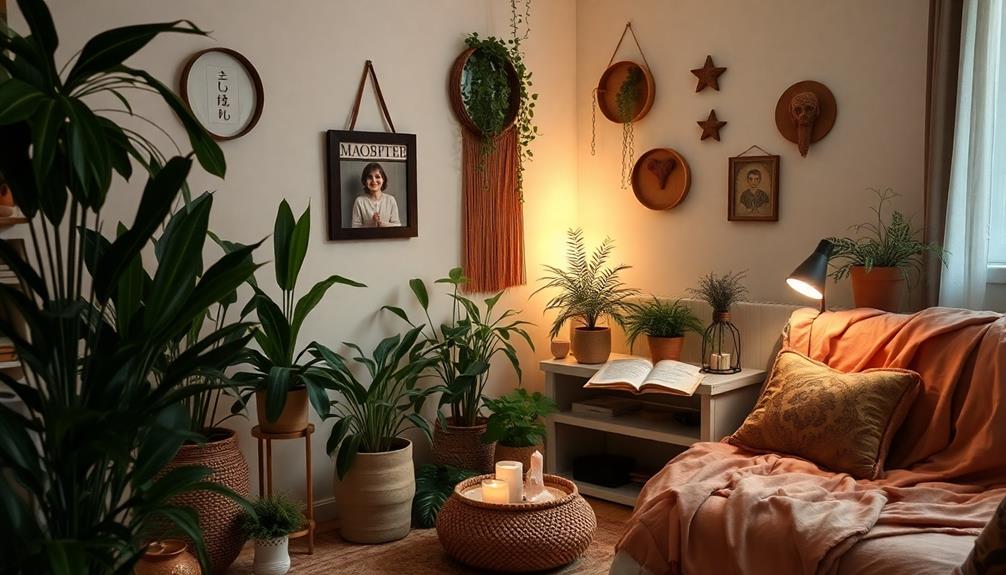
Personalizing your Feng Shui approach can transform your space into a true reflection of your unique energy and aspirations.
Start by determining your Kua number, which you can calculate using your birth date and gender. This number reveals your lucky directions, essential for enhancing your personal energy.
Next, incorporate meaningful objects and colors that resonate with you. Focus on specific hues linked to the five elements—wood, fire, earth, metal, and water—to amplify positive energy.
Arrange your furniture and decor to align with your lucky direction, creating an environment that supports your goals.
Utilize the Bagua map to pinpoint areas of your life you wish to enhance, like career or love.
Personalize those spaces with elements that resonate with your intentions.
Frequently Asked Questions
How Long Does It Take to Feel Feng Shui Effects?
You might start feeling the effects of feng shui within a few days, but significant changes often take weeks to manifest. It really depends on your space and how consistently you apply the principles.
Can Feng Shui Improve Relationships in My Home?
Yes, feng shui can improve relationships in your home. By arranging your space thoughtfully and removing clutter, you create an environment that fosters connection, harmony, and positive energy, which can enhance your interactions with loved ones.
Is It Necessary to Hire a Feng Shui Expert?
Just like a skilled conductor brings harmony to an orchestra, hiring a feng shui expert can enhance your space's energy. However, if you're willing to learn, you can also apply principles yourself and achieve balance.
What Should I Do if I Can't Rearrange Furniture?
If you can't rearrange furniture, focus on decluttering and adding plants or mirrors to enhance energy flow. You can also change decor colors or use specific items to create balance and harmony in your space.
Can I Use Feng Shui Principles in My Garden?
Studies show that green spaces can reduce stress by up to 30%. You can apply feng shui principles in your garden by creating balance, using natural elements, and ensuring a harmonious flow of energy.
Conclusion
In a world filled with chaos, your home can be a sanctuary of peace. By embracing feng shui principles and making simple adjustments, you can transform your space from overwhelming to tranquil. Imagine stepping into a room that radiates calm instead of clutter. With personal touches and mindful choices, you'll not only enhance your environment but also nurture your well-being. Don't just live in your space—let it support and uplift you. Your peaceful retreat awaits!
-

 Mom5 months ago
Mom5 months agoHeartfelt Poems for Your Daughter’s Birthday
-

 Mom5 months ago
Mom5 months agoHappy Birthday Religious Wishes and Blessings
-

 Mom5 months ago
Mom5 months agoHappy 65th Birthday: Celebrate Your Special Day!
-

 Mom5 months ago
Mom5 months agoHappy Birthday in Heaven from Daughter: Remembering You
-

 Mom5 months ago
Mom5 months ago62nd Birthday Quotes for Mom: Celebrate Her Special Day
-

 Mom5 months ago
Mom5 months agoCelebrating 60 Years: Happy 60th Birthday Wishes
-

 Special Occasions4 months ago
Special Occasions4 months agoUplifting Words: Inspirational Church Anniversary Messages!
-

 Mom5 months ago
Mom5 months agoCelebrate a Joyous Happy 70th Birthday Milestone!

















